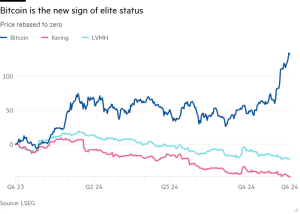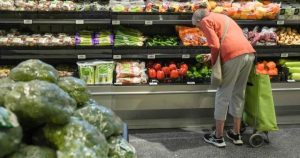How value chains survived the great inflation without state help
Unlock the Editor’s Digest for free
Roula Khalaf, Editor of the FT, selects her favourite stories in this weekly newsletter.
It’s always dangerous to declare victory in a war against inflation. But the surge in prices that started after Covid hit in 2020 and got fresh momentum from the 2022 Russian invasion of Ukraine has now very definitely moderated. The production line for postmortems of the great inflation and lessons for next time has been humming along for more than a year.
Many focus on whether central banks were skilful or got lucky. But there are also morals for industrial and trade policy. The evidence suggests the case for widespread government intervention in a value chain just because it was under strain during the twin Covid-Ukraine crises remains weak.
First, let’s define exactly what we mean. Government value chain intervention can make sense in areas involving genuine security threats especially related to geopolitics. These include the supply of critical inputs and investing in high-end sensitive technology. But it’s more doubtful whether the everyday plumbing of world trade — ports, distribution centres, the manufacture of intermediate inputs — needs fixing.
Conclusions about the causes of the great inflation are highly sensitive to how you set the model up. But there are some agreed salient features. One, a massive Covid-related surge in consumer demand, particularly for durable goods, driving their prices higher. Two, graphic examples of supply chain problems, including congestion in US ports and shortages of semiconductors. Three, energy and food price shocks after the Ukraine invasion, particularly in Europe.

World Bank lead trade economist Phil Levy, formerly of the global logistics technology company Flexport, points out in a new paper for the Peterson Institute that the evidence strongly suggests the pandemic-related supply chain contributions to inflation came through surges in consumer durables demand, not shocks to supply. While the west coast US ports experienced congestion and long delays which rippled out into sharply higher global freight rates, they were nonetheless processing record numbers of containers.
The shortages of semiconductors in 2020 and 2021 are also often held up as an example of a supply shock, in this case affecting global value chains in cars. But as Levy points out, worldwide and US billings (sales) of semiconductor sales in real terms were higher in 2020 and 2021.

What happened is that car manufacturers, not unreasonably extrapolating from earlier recessions, wrongly anticipated a prolonged slump in demand. By the time they realised it wasn’t happening, chipmakers’ order books were full with requests from electronics manufacturers. Consumers stuck at home were buying laptops for their endless tedious Zoom work calls and relieving the tedium in between with PlayStations and large-screen TVs.

Even the famous flour and toilet paper shortages that afflicted many countries were demand-driven. The lockdowns resulted in people suddenly stuck at home baking Instagrammable sourdough loaves and bulk-buying the kind of toilet paper used in homes rather than offices. Supply chains for flour and hygiene products could not instantly adjust.
The inability of particular supply chains to adapt quickly enough to an extraordinary surge in demand is not a supply shock. Nor does it necessarily justify government meddling unless you think bureaucrats will do better in projecting demand for containers or toilet paper than shipping lines or supermarkets do.
The actual supply dislocation came later with the Ukraine invasion, which drove oil, gas and food prices higher by reducing hydrocarbon and grain exports from Russia and disrupting sea traffic more generally. In the event, those shocks were cushioned by remarkably fast diversification away from Russian gas on the part of western Europe, and global food markets performing gratifyingly well.
The case for government intervention in value chains is limited. Maintaining spare capacity in case the highly unusual pandemic-era demand-supply mismatches recur either means forcibly saddling private sector companies with costs or putting them on a permanent drip of government spending subject to future political whim.
Even if it were possible, for example, to expand the capacity of US ports, it could lead to facilities that lie mainly empty most of the time. Similarly, the US federal government has gone into the semiconductor business with the Chips Act, but most of the money is focused on leading-edge technologies and diversifying away from production locations subject to serious political risk (Taiwan), which makes some sense. It’s an exceedingly open question whether the US wants permanently to subsidise spare manufacturing capacity for the kind of legacy chips that go into cars.
Certainly, governments can improve access to information to help companies make better decisions. In the same way the 2007-2008 global food crisis sparked the creation of the Agricultural Market Information System to provide timely data on commodity production, stocks and volumes, the supply chain snarl-ups have spawned valuable supply chain diagnostic and monitoring services from the US Commerce and Transportation departments, the IMF and others.

But actually investing for future risks is best done by the businesses that have money at stake. There are signs they are doing so. US wholesale inventories, unusually, are above retail inventories, suggesting supply chain managers are holding higher stocks as insurance.
The next bout of inflation to come along — or indeed of deflation, or recession, or financial market meltdown, who knows — will inevitably be of a different nature. Rather than intervening heavily to defeat an already-departed enemy, governments should focus on providing information to enable companies to adapt and survive the next shock. Contrary to much hysteria at the time, the 2020-2022 experience did not inflict permanent damage on value chains. We can mainly thank businesses for the great escape from the great inflation.
#chains #survived #great #inflation #state




